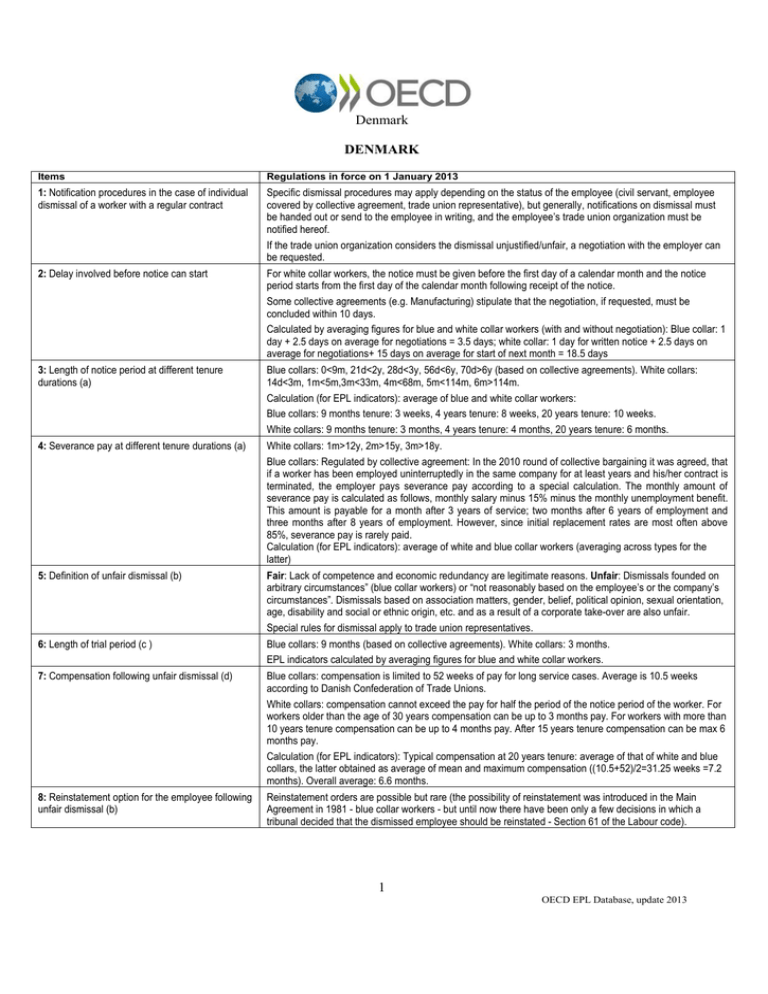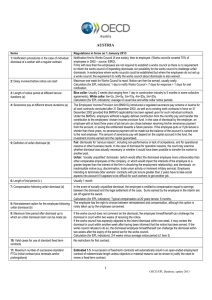Denmark
Anuncio

Denmark DENMARK Items Regulations in force on 1 January 2013 1: Notification procedures in the case of individual dismissal of a worker with a regular contract Specific dismissal procedures may apply depending on the status of the employee (civil servant, employee covered by collective agreement, trade union representative), but generally, notifications on dismissal must be handed out or send to the employee in writing, and the employee’s trade union organization must be notified hereof. If the trade union organization considers the dismissal unjustified/unfair, a negotiation with the employer can be requested. 2: Delay involved before notice can start For white collar workers, the notice must be given before the first day of a calendar month and the notice period starts from the first day of the calendar month following receipt of the notice. Some collective agreements (e.g. Manufacturing) stipulate that the negotiation, if requested, must be concluded within 10 days. Calculated by averaging figures for blue and white collar workers (with and without negotiation): Blue collar: 1 day + 2.5 days on average for negotiations = 3.5 days; white collar: 1 day for written notice + 2.5 days on average for negotiations+ 15 days on average for start of next month = 18.5 days 3: Length of notice period at different tenure durations (a) Blue collars: 0<9m, 21d<2y, 28d<3y, 56d<6y, 70d>6y (based on collective agreements). White collars: 14d<3m, 1m<5m,3m<33m, 4m<68m, 5m<114m, 6m>114m. Calculation (for EPL indicators): average of blue and white collar workers: Blue collars: 9 months tenure: 3 weeks, 4 years tenure: 8 weeks, 20 years tenure: 10 weeks. White collars: 9 months tenure: 3 months, 4 years tenure: 4 months, 20 years tenure: 6 months. 4: Severance pay at different tenure durations (a) White collars: 1m>12y, 2m>15y, 3m>18y. Blue collars: Regulated by collective agreement: In the 2010 round of collective bargaining it was agreed, that if a worker has been employed uninterruptedly in the same company for at least years and his/her contract is terminated, the employer pays severance pay according to a special calculation. The monthly amount of severance pay is calculated as follows, monthly salary minus 15% minus the monthly unemployment benefit. This amount is payable for a month after 3 years of service; two months after 6 years of employment and three months after 8 years of employment. However, since initial replacement rates are most often above 85%, severance pay is rarely paid. Calculation (for EPL indicators): average of white and blue collar workers (averaging across types for the latter) 5: Definition of unfair dismissal (b) Fair: Lack of competence and economic redundancy are legitimate reasons. Unfair: Dismissals founded on arbitrary circumstances” (blue collar workers) or “not reasonably based on the employee’s or the company’s circumstances”. Dismissals based on association matters, gender, belief, political opinion, sexual orientation, age, disability and social or ethnic origin, etc. and as a result of a corporate take-over are also unfair. Special rules for dismissal apply to trade union representatives. 6: Length of trial period (c ) Blue collars: 9 months (based on collective agreements). White collars: 3 months. EPL indicators calculated by averaging figures for blue and white collar workers. 7: Compensation following unfair dismissal (d) Blue collars: compensation is limited to 52 weeks of pay for long service cases. Average is 10.5 weeks according to Danish Confederation of Trade Unions. White collars: compensation cannot exceed the pay for half the period of the notice period of the worker. For workers older than the age of 30 years compensation can be up to 3 months pay. For workers with more than 10 years tenure compensation can be up to 4 months pay. After 15 years tenure compensation can be max 6 months pay. Calculation (for EPL indicators): Typical compensation at 20 years tenure: average of that of white and blue collars, the latter obtained as average of mean and maximum compensation ((10.5+52)/2=31.25 weeks =7.2 months). Overall average: 6.6 months. 8: Reinstatement option for the employee following unfair dismissal (b) Reinstatement orders are possible but rare (the possibility of reinstatement was introduced in the Main Agreement in 1981 - blue collar workers - but until now there have been only a few decisions in which a tribunal decided that the dismissed employee should be reinstated - Section 61 of the Labour code). 1 OECD EPL Database, update 2013 Denmark 9: Maximum time period after dismissal up to which an unfair dismissal claim can be made (e) Unfair dismissal claims can be made within a short period after notification. For example the 1973 General Agreement stipulates that “If the employee claims that the dismissal is unfair an unwarranted by the situation of the employee and the company, a request may be made for the case to be settled locally between representatives of management and employees. The local negotiations shall be completed within two weeks of notice being given.” In addition, “in cases where claim is made to set aside a dismissal, the proceedings shall, as far as possible, be completed before the relevant employee’s term of notice expires.” (Section 4, 1973 General Agreement concluded by the Danish Employers´ Confederation and the Danish Confederation of Trade Unions). Calculation (for EPL indicators): 2 weeks on average (minus average notice period) 10: Valid cases for use of standard fixed term contracts Fixed-term contracts allowed for specified periods of time and/or for specific tasks Particularly used in professional services and construction, but also in other industries. Renewal of fixed term contracts must be based on “objective criteria”. 11: Maximum number of successive standard FTCs (initial contract plus renewals and/or prolongations) Generally, there is no legal limit for the maximum number of successive fixed-term contracts, but renewal of fixed-term contracts must be based on objective reasons (“objective criteria such as a specific date, the completion of a specific task or the occurrence of a specific event”, as stated e.g. in the Act on the Legal Relationship between Employers and Salaried Employees, Sec. 1(4)). The Confederation of Salaried Employees and Civil Servants in Denmark (FTF) states that usually 2 successive renewals can be based on objective reasons. 3 or more insinuate suspicion of breaches of e.g. Salaried Employees Act, so that there is a risk that a court will declare the contract null and void, in case the contract is not renewed based on objective reasons. 12: Maximum cumulated duration of successive standard FTCs There are no limits if objective reasons but in practice max. 2 years 13: Types of work for which temporary work agency (TWA) employment is legal Generally allowed 14: Are there restrictions on the number of renewals and/or prolongations of TWA assignments? (f) No but the Danish Confederation of Trade Unions states that court rulings suggest that 4-5 renewals entail notification procedures. 15: Maximum cumulated duration of TWA assignments (f) The Danish Confederation of Trade Unions states that there is no limit, if employment breaks in between consecutive assignments. 16: Does the set-up of a TWA require authorisation or reporting obligations? No requirements except company registration. 17: Do regulations ensure equal treatment of regular workers and agency workers at the user firm? Yes, equal treatment regarding pay and working conditions 18: Definition of collective dismissal (b) Within 30 days, >9 workers in firms 21-99 employees; >9% in firms 100-299; >29 workers in firms 300+ employees. Firms with 20 employees or less are exempt from requirements for collective dismissals. 19: Additional notification requirements in cases of collective dismissal (g) Notification of Regional Employment Council (tripartite council) plus the Union and Employers org. (collective agreements provisions). 20: Additional delays involved in cases of collective dismissal (h) Negotiations with unions before informing the Regional Employment Council (at least 21 days in firms >100 workers or that seek to dismiss over half of staff). Within ten days, this communication is followed by the communication of the list of affected employees to Regional Employment Council but no earlier than 30 days before effective termination (longer requirements in firms >100 workers or that seek to dismiss over half of staff). Affected workers cannot be notified before PES. Individual notice can be given at the same time as the list is communicated to the Regional Employment Council – cf. Act respecting advance notice etc. in connection with mass lay-offs, sec. 7 and 8. 21: Other special costs to employers in case of collective dismissals (i) Type of negotiation required: National agreement obliges companies to organise transfer and/or retraining whenever possible. Selection criteria: No criteria laid down by law. Severance pay: No special regulations for collective dismissal. The collective agreement for the financial sector requires obligatory outplacement and severance pay above the law plus other provisions. 2 OECD EPL Database, update 2013 Denmark Legend: d: days; w: weeks; m: months; y: years. For example “1m < 3y” means “1 month of notice (or severance) pay is required when length of service is below 3 years”. Notes: a) Three tenure durations (9 months, 4 years, 20 years). Case of a regular employee with tenure beyond any trial period, dismissed on personal grounds or economic redundancy, but without fault (where relevant, calculations of scores to compute OECD EPL indicators assume that the worker was 35 years old at the start of employment). Averages are taken where different situations apply – e.g. blue collar and white collar; dismissals for personal reasons and for redundancy. b) Based also on case law, if court practice tends to be more (or less) restrictive than what specified in legislation. c) Initial period within which regular contracts are not fully covered by employment protection provisions and unfair dismissal claims cannot usually be made. d) Typical compensation at 20 years of tenure, including back pay and other compensation (e.g. for future lost earnings in lieu of reinstatement or psychological injury), but excluding ordinary severance pay and pay in lieu of notice. Where relevant, calculations of scores to compute OECD EPL indicators assume that the worker was 35 years old at the start of employment and that a court case takes 6 months on average. Description based also on case law. e) Maximum time period after dismissal up to which an unfair dismissal claim can be made. f) Description based on both regulations on number and duration of the contract(s) between the temporary work agency and the employee and regulations on the number and duration of the assignment(s) with the same user firm. g) Notification requirements to works councils (or employee representatives), and to government authorities such as public employment offices. Only requirements on top of those requirements applying to individual redundancy dismissal count for the OECD EPL indicators (cf. Item 1). h) Additional delays and notice periods in the case of collective dismissal (only delays on top of those required for individual dismissals – as reported in Items 2 and 3 – count for the OECD EPL indicators). i) This refers to whether there are additional severance pay requirements and whether social compensation plans (detailing measures of reemployment, retraining, outplacement, etc.) are obligatory or common practice. 3 OECD EPL Database, update 2013


